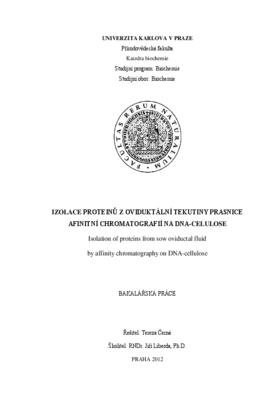Izolace proteinů z oviduktální tekutiny prasnice afinitní chromatografií na DNA-celulose
Isolation of proteins from sow oviductal fluid by affinity chromatography on DNA cellulose
bachelor thesis (DEFENDED)

View/
Permanent link
http://hdl.handle.net/20.500.11956/40417Identifiers
Study Information System: 116220
Collections
- Kvalifikační práce [20291]
Author
Advisor
Referee
Ryšlavá, Helena
Faculty / Institute
Faculty of Science
Discipline
Biochemistry
Department
Department of Biochemistry
Date of defense
11. 6. 2012
Publisher
Univerzita Karlova, Přírodovědecká fakultaLanguage
Czech
Grade
Very good
Keywords (Czech)
afinitní chromatografie, antimikrobiální aktivita, glykosidasová aktivita, oviduktální tekutina, prasnice, proteiny podobné histonůmKeywords (English)
affinity chromatography, antimicrobial activity, glycosidases activity, histone-like proteins, oviductal fluid, sowOviduktální tekutina byla izolována z vejcovodů prasnice, tekutina byla zmražena a lyofilizována pro následnou chromatografickou separaci na DNA-celulose a pro stanovení antimikrobiální a glykosidasové aktivity. Afinitní chromatografií na DNA-celulose byly separovány dvě frakce - proteklá a vázající. SDS-elektroforézou byly detekovány čtyři zóny - tři zóny o relativních molekulových hmotnostech 15 000 - 21 000, odpovídající relativní molekulovou hmotností histonům, a čtvrtá zóna o ~ 34 000. Tyto zóny jsou odeslány na identifikaci pomocí analýzy MALDI-TOF. Byla prokázána antimikrobiální aktivita ve frakci izolované na DNA-celulose, a to ve frakci, která se nevázala; a v celkové oviduktální tekutině. Ve vázající frakci nebyla sledována antimikrobiální aktivita, neboť afinitní chromatografie neposkytla dostatečné množství proteinů pro relevantní stanovení. Byla potvrzena přítomnost glykosidasové aktivity v celkové oviduktální tekutině.
Oviductal fluid was isolated from sow oviduct and then frozen and lyophilized. The obtained material was separated by affinity chromatography on DNA-cellulose and used as well for determination of antimicrobial and glycosidases activity. Two fractions - non-binding and bound - were obtained by affinity chromatography on DNA-cellulose. Four protein zones were detected on the SDS-electrophoreogram in the binding fraction of chromatographic separation - three zones with relative molecular weight 15 000 - 21 000. These zones correspond by their relative molecular weights to relative molecular weight of histones. The last zone was corresponding to ~ 34 000. All of these zones were sent for identification using MALDI-TOF analysis. The antimicrobial activity was detected in the non-binding fraction and in oviductal fluid. Contrary to this, the antimicrobial activity was not present in the bound fraction, due to the fact that in this case only an insignificant amount of proteins was found in the bound fraction. The presence of the glycosidases activity was shown in oviductal fluid. (In Czech)
